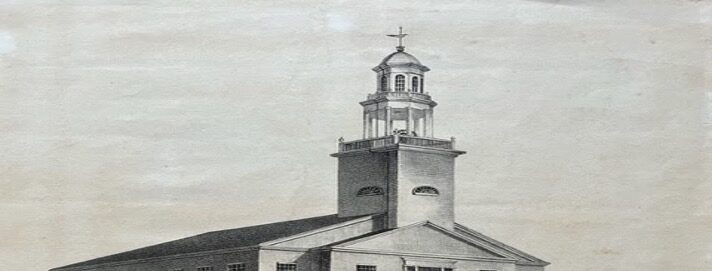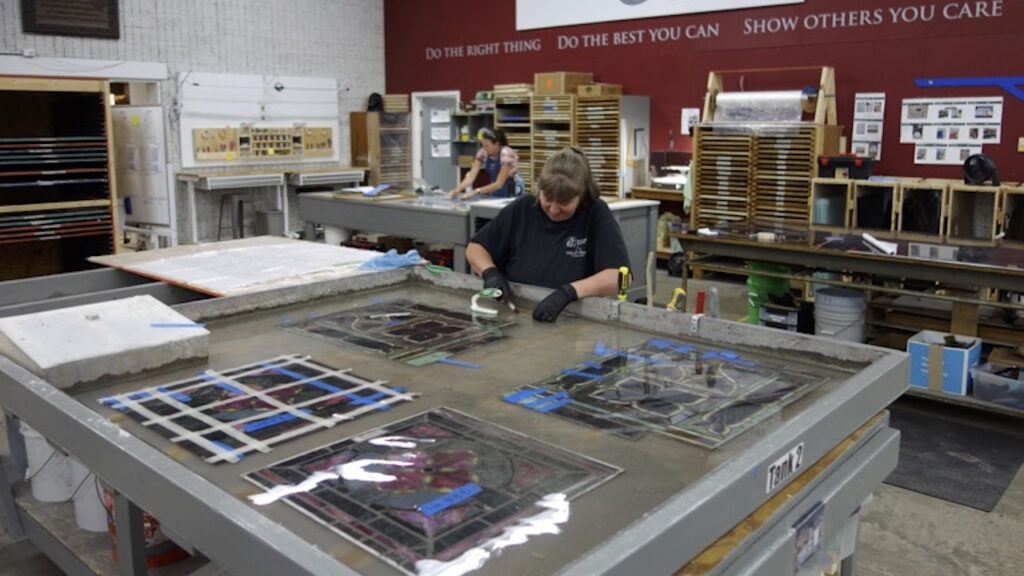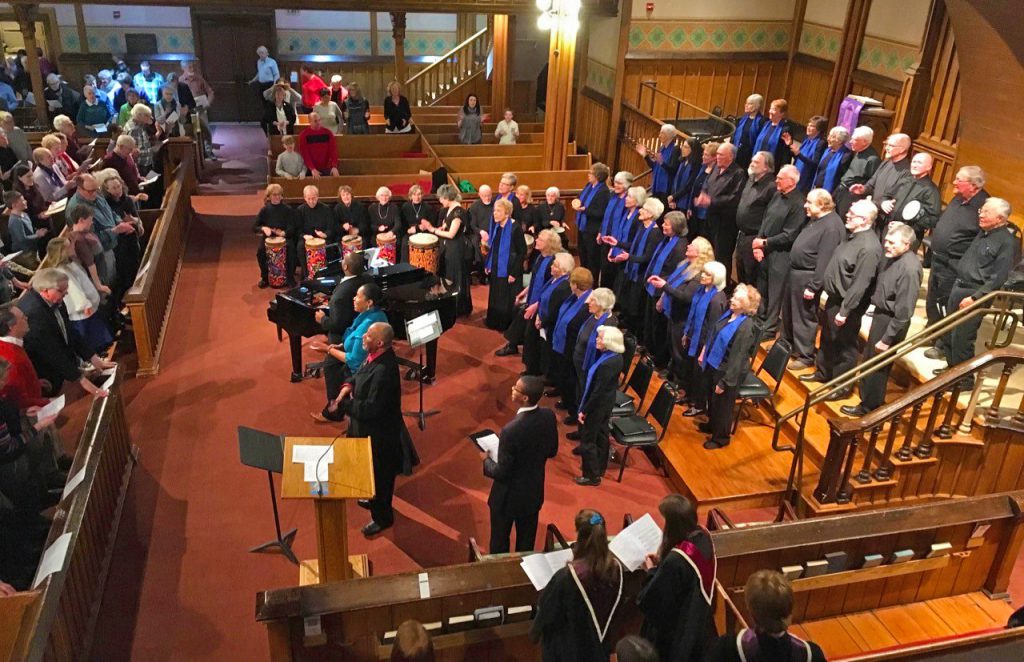By:
NEWS
From the Archives... "Our Indoor and Outdoor Labyrinths"
Nearly 25 years ago, Susan Fitzgerald, our Christian Education Director at the time, with the help of other members of our church decided to create an indoor labyrinth for anyone from our greater community to use. Janet Galle, a member of our church, wrote an informative article for the March 3, 2000 issue of our local newspaper, The Times Record. “A growing movement in the United States, gaining recognition since a 1998 New York Times article and reemphasized by the Veriditas Labyrinth Project at Grace Cathedral in San Francisco, is the use of the labyrinth for spiritual and meditative journeys. Not a maze which has dead ends and tricks in its layout, the labyrinth is a universal path. There is only one way to the center, which you can always see from the very beginning. The walker enters and exits from the same point. Often called a physical metaphor for spiritual or healing journeys, a contemplative tool or a path to inner peace, walking a labyrinth has come to have many meanings for individuals. Labyrinths have been found in ancient Crete, built more than 4000 years ago; Tibetan monks make sand mandalas. One of two canvas labyrinths in Maine (the other is located at Bates College), First Parish Church’s labyrinth project was just completed this February (2000).”
Susan Fitzgerald had seen a labyrinth design five years earlier and was intrigued by “something deep and appealing about the pattern. Without knowing anything, I was instinctively drawn to it.” She reached out to the Grace Cathedral in San Francisco and learned about the Wellesley Village Congregational Church in Massachusetts before seeking interest from many churches in Brunswick. (A side note, years later, Rev. Allen was a Pastoral Resident for two years following his seminary graduation at the Wellesley church.) Several people traveled to Bates and Wellesley to walk a labyrinth and were interested in helping with this worthwhile project. Financial support came from our church’s memorial funds given in memory of Kay Black, Dorothea Johnson, and Bunt and Bibbo Whitman. William Geoghegan, a retired Professor of Religion at Bowdoin and member of our church, brought the labyrinth from Bates to First Parish so people could walk it. Later, Susan walked another labyrinth at a retreat. Here were her observations of that experience: “marvelous, because I wasn’t analyzing or planning, I was totally unencumbered. That retreat was the best time I’ve walked it. That’s what I see a labyrinth can do – free us from ourselves. Part of what the labyrinth has done is make the experience of God very real and personal. A lot of times in religion we go about it vicariously, we process about God on cerebral levels using other people’s words. The labyrinth provides a personal experience. It’s a metaphor for our spiritual journey. We are all on the path, just with different points and turns and experiences of getting there. We are all searching for meaning.”
Once Susan and a group of people from First Parish Church decided to undertake this project, they spent five Saturdays putting together the labyrinth that was based on the pattern of the pavement labyrinth that was built into the floor of Chartres Cathedral in France in the 13th century. It includes 11 rings or circuits. Ben Below, community member, builder and son of Caroline and Ralph Below (retired Navy chaplain), active members of First Parish Church, who had read about a labyrinth being constructed eight years earlier on Block Island. He was interested in “how Christian churches, especially those in England, were built on points of intersection of ley lines – originally Celtic and spiritual sites – and it struck me as connected. Ley lines are paths of earth energy, straight arrow lines that cannot be seen but are sensed or dowsed. They are everywhere and are noted especially in the ancient world where there’s a consistent civilization to maintain them.” He admitted that seeing the huge canvas in Fellowship Hall was “so big, but figuring out the geometry to draw the 11 circuits was obvious and simple as can be. Practical geometry is my bread and butter.”
“The fabric, a heavy-duty canvas that consists of three 12 feet wide and 35 feet long strips, was purchased in New York City. Jim Hill of Hill’s Upholstery in Topsham tackled the tremendous job of hemming the individual pieces and then sewing industrial-strength velcro along the overlapping edges. The three strips fit together perfectly to form a 35 by 35 foot square.”
The late Ann Barry, “writer, spiritual leader and member of First Parish Church who was also instrumental in the completion of this labyrinth, was quoted, “Meditation has been part of my life for a long time, so I am intentional about walking being meditation. Sometimes it is special, and sometimes it is just a nice walk. I don’t walk with the idea that ‘oh, something has to happen.’ A labyrinth is not magic. Anybody seeking a closer connection with whatever higher power, whatever term they use…may find a labyrinth calming, centering, connecting.”
“Rev. Dr. William Imes, pastor of First Parish Church (1985-2001), compares the walking of the labyrinth – which is now ready for all people – to a pilgrimage, a symbolic, sacred journey which can be taken here and now and does not require that one travel to a holy place.”
In the Christian Education section of our church’s annual report in 2001, Susan included this information on the labyrinth. “With over 200 people on our mailing list, the labyrinth continues to reach a broad segment of the population. We hosted several UCC and other youth groups, women’s groups, a group of women recovering from addiction, and a Bowdoin class on Art and Contemplation. We loaned the labyrinth to USM, UNE, a Falmouth High School medieval art class and other churches. In March, 50 people attended my worship on labyrinths and over 200 people walked it at the New England Women’s Celebration in Vermont. On the first anniversary of September 11th, 145 people walked either our canvas or the temporary outdoor labyrinth in the backyard of the church. Close to 175 people attended the Brunswick Area Interfaith Council service of prayer in our sanctuary on that day. She was grateful to the following “Labyrinth Tenders” who help set up and tend the labyrinth during the hours of Noon – 7:00 p.m. for the monthly walks and special days (Ash Wednesday, Good Friday) when the labyrinth was available: Ann Barry, Doffie Barstow, Judy Bauman, Caroline Below, Jan Bodwell, Lauren Catlett, Marilyn Dwyer, Janet Galle, Louisa Gray, Shirley Green, Ruth Hoffman, Elizabeth Knowles, Suzie Moran, Annette Mott, Paula Price, Jane Primmer, Mary Sistare, Mary Lee Ward and Jackie Wild.”
Please view our sanctuary archive display to see more information, articles and photos on our indoor and outdoor labyrinth. Next month this article will focus on the history of our outdoor labyrinth. Meanwhile, between now and then, I hope that you will make the time to walk our indoor or outdoor labyrinths.
Below are some church bulletins from both 1923 and 1973 that include interesting information and some familiar names.
Church bulletin from November 1923 (100 years ago):
Church Bulletin from November 18, 1973 (50 years ago):
Blessings to you and your family as we feast on gratitude this month.















